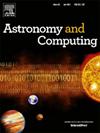More than a void? The detection and characterization of cavities in a simulated galaxy’s interstellar medium
IF 1.8
4区 物理与天体物理
Q2 ASTRONOMY & ASTROPHYSICS
引用次数: 0
Abstract
The interstellar medium of galaxies is filled with holes, bubbles, and shells, typically interpreted as remnants of stellar evolution. There is growing interest in the study of their properties to investigate stellar and supernova feedback. So far, the detection of cavities in observational and numerical data is mostly done visually and, hence, is prone to biases. Therefore, we present an automated, objective method for discovering cavities in particle simulations, with demonstrations using hydrodynamical simulations of a dwarf galaxy. The suggested technique extracts holes based on the persistent homology of particle positions and identifies tight boundary points around each. With a synthetic ground-truth analysis, we investigate the relationship between data density and the detection radius, demonstrating that higher data density also allows for the robust detection of smaller cavities. By tracking the boundary points, we can measure the shape and physical properties of the cavity, such as its temperature. In this contribution, we detect 808 holes in 21 simulation snapshots. We classified the holes into supernova-blown bubbles and cavities unrelated to stellar feedback activity based on their temperature profile and expansion behaviour during the 100 million years covered by the simulation snapshots analysed for this work. Surprisingly, less than 40% of the detected cavities can unequivocally be linked to stellar evolution. Moreover, about 36% of the cavities are contracting, while 59% are expanding. The rest do not change for a few million years. Clearly, it is erroneous to interpret observational data based on the premise that all cavities are supernova-related and expanding. This study reveals that supernova-driven bubbles typically exhibit smaller diameters, larger expansion velocities, and lower kinetic ages (with a maximum of 220 million years) compared to other cavities.
不仅仅是空虚?模拟星系星际介质中空腔的探测和表征
星系的星际介质充满了洞、气泡和壳,通常被解释为恒星演化的残留物。人们对研究它们的性质以研究恒星和超新星的反馈越来越感兴趣。到目前为止,观测和数值数据中空洞的探测主要是通过视觉完成的,因此容易产生偏差。因此,我们提出了一种在粒子模拟中发现空腔的自动化、客观的方法,并利用矮星系的流体动力学模拟进行了演示。该技术基于粒子位置的持续同源性提取孔洞,并识别每个孔洞周围的紧密边界点。通过合成的真值分析,我们研究了数据密度和检测半径之间的关系,证明了更高的数据密度也允许对较小的空腔进行鲁棒检测。通过跟踪边界点,我们可以测量空腔的形状和物理性质,如温度。在本文中,我们在21个模拟快照中检测到808个漏洞。我们根据为这项工作分析的模拟快照所涵盖的1亿年的温度分布和膨胀行为,将这些洞分为超新星吹出的气泡和与恒星反馈活动无关的空洞。令人惊讶的是,在探测到的空腔中,只有不到40%可以明确地与恒星演化联系起来。此外,大约36%的蛀牙在收缩,59%的蛀牙在扩张。其余的在几百万年里都不会改变。显然,把观测数据建立在所有空腔都与超新星有关并不断膨胀的前提上是错误的。这项研究表明,与其他空腔相比,超新星驱动的气泡通常具有较小的直径,较大的膨胀速度和较低的动力学年龄(最大为2.2亿年)。
本文章由计算机程序翻译,如有差异,请以英文原文为准。
求助全文
约1分钟内获得全文
求助全文
来源期刊

Astronomy and Computing
ASTRONOMY & ASTROPHYSICSCOMPUTER SCIENCE,-COMPUTER SCIENCE, INTERDISCIPLINARY APPLICATIONS
CiteScore
4.10
自引率
8.00%
发文量
67
期刊介绍:
Astronomy and Computing is a peer-reviewed journal that focuses on the broad area between astronomy, computer science and information technology. The journal aims to publish the work of scientists and (software) engineers in all aspects of astronomical computing, including the collection, analysis, reduction, visualisation, preservation and dissemination of data, and the development of astronomical software and simulations. The journal covers applications for academic computer science techniques to astronomy, as well as novel applications of information technologies within astronomy.
 求助内容:
求助内容: 应助结果提醒方式:
应助结果提醒方式:


